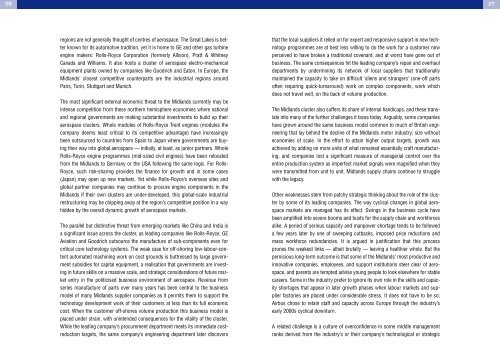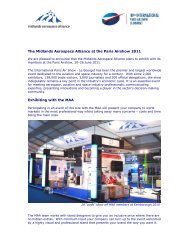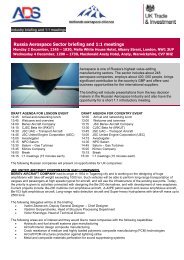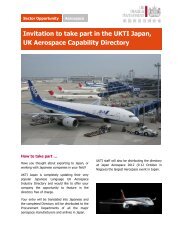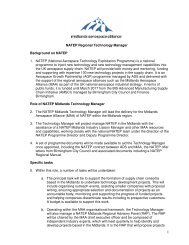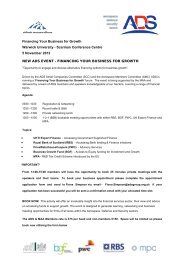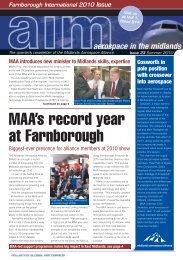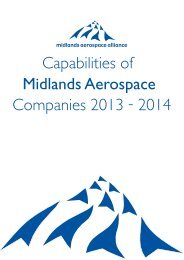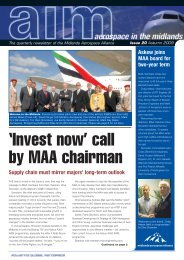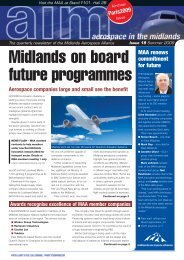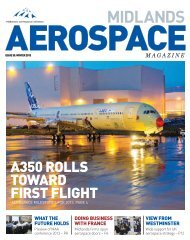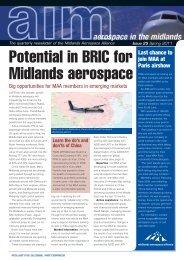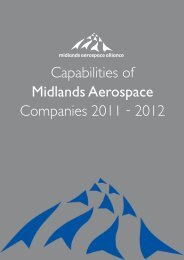Mobilising the Midlands aerospace cluster
Mobilising the Midlands aerospace cluster
Mobilising the Midlands aerospace cluster
- No tags were found...
You also want an ePaper? Increase the reach of your titles
YUMPU automatically turns print PDFs into web optimized ePapers that Google loves.
26<br />
27<br />
regions are not generally thought of centres of <strong>aerospace</strong>. The Great Lakes is better<br />
known for its automotive tradition, yet it is home to GE and o<strong>the</strong>r gas turbine<br />
engine makers: Rolls-Royce Corporation (formerly Allison), Pratt & Whitney<br />
Canada and Williams. It also hosts a <strong>cluster</strong> of <strong>aerospace</strong> electro-mechanical<br />
equipment plants owned by companies like Goodrich and Eaton. In Europe, <strong>the</strong><br />
<strong>Midlands</strong>’ closest competitive counterparts are <strong>the</strong> industrial regions around<br />
Paris, Turin, Stuttgart and Munich.<br />
The most significant external economic threat to <strong>the</strong> <strong>Midlands</strong> currently may be<br />
intense competition from <strong>the</strong>se nor<strong>the</strong>rn hemisphere economies where national<br />
and regional governments are making substantial investments to build up <strong>the</strong>ir<br />
<strong>aerospace</strong> <strong>cluster</strong>s. Whole modules of Rolls-Royce Trent engines (modules <strong>the</strong><br />
company deems least critical to its competitive advantage) have increasingly<br />
been outsourced to countries from Spain to Japan where governments are buying<br />
<strong>the</strong>ir way into global <strong>aerospace</strong> — initially, at least, as junior partners. Whole<br />
Rolls-Royce engine programmes (mid-sized civil engines) have been relocated<br />
from <strong>the</strong> <strong>Midlands</strong> to Germany or <strong>the</strong> USA following <strong>the</strong> same logic. For Rolls-<br />
Royce, such risk-sharing provides <strong>the</strong> finance for growth and in some cases<br />
(Japan) may open up new markets. Yet while Rolls-Royce’s overseas sites and<br />
global partner companies may continue to procure engine components in <strong>the</strong><br />
<strong>Midlands</strong> if <strong>the</strong>ir own <strong>cluster</strong>s are under-developed, this global-scale industrial<br />
restructuring may be chipping away at <strong>the</strong> region’s competitive position in a way<br />
hidden by <strong>the</strong> overall dynamic growth of <strong>aerospace</strong> markets.<br />
The parallel but distinctive threat from emerging markets like China and India is<br />
a significant issue across <strong>the</strong> <strong>cluster</strong>, as leading companies like Rolls-Royce, GE<br />
Aviation and Goodrich outsource <strong>the</strong> manufacture of sub-components even for<br />
critical core technology systems. The weak case for off-shoring low-labour-content<br />
automated machining work on cost grounds is buttressed by large government<br />
subsidies for capital equipment, a realisation that governments are investing<br />
in future skills on a massive scale, and strategic considerations of future market<br />
entry in <strong>the</strong> politicised business environment of <strong>aerospace</strong>. Revenue from<br />
series manufacture of parts over many years has been central to <strong>the</strong> business<br />
model of many <strong>Midlands</strong> supplier companies as it permits <strong>the</strong>m to support <strong>the</strong><br />
technology development work of <strong>the</strong>ir customers at less than its full economic<br />
cost. When <strong>the</strong> customer off-shores volume production this business model is<br />
placed under strain, with unintended consequences for <strong>the</strong> vitality of <strong>the</strong> <strong>cluster</strong>.<br />
While <strong>the</strong> leading company’s procurement department meets its immediate costreduction<br />
targets, <strong>the</strong> same company’s engineering department later discovers<br />
that <strong>the</strong> local suppliers it relied on for expert and responsive support in new technology<br />
programmes are at best less willing to do <strong>the</strong> work for a customer now<br />
perceived to have broken a traditional covenant, and at worst have gone out of<br />
business. The same consequences hit <strong>the</strong> leading company’s repair and overhaul<br />
departments by undermining its network of local suppliers that traditionally<br />
maintained <strong>the</strong> capacity to take on difficult ‘aliens and strangers’ (one-off parts<br />
often requiring quick-turnaround) work on complex components, work which<br />
does not travel well, on <strong>the</strong> back of volume production.<br />
The <strong>Midlands</strong> <strong>cluster</strong> also suffers its share of internal handicaps, and <strong>the</strong>se translate<br />
into many of <strong>the</strong> fur<strong>the</strong>r challenges it faces today. Arguably, some companies<br />
have grown around <strong>the</strong> same business model common to much of British engineering<br />
that lay behind <strong>the</strong> decline of <strong>the</strong> <strong>Midlands</strong> motor industry; size without<br />
economies of scale. In <strong>the</strong> effort to attain higher output targets, growth was<br />
achieved by adding on more units of what remained essentially craft manufacturing,<br />
and companies lost a significant measure of managerial control over <strong>the</strong><br />
entire production system as imperfect market signals were magnified when <strong>the</strong>y<br />
were transmitted from unit to unit. <strong>Midlands</strong> supply chains continue to struggle<br />
with <strong>the</strong> legacy.<br />
O<strong>the</strong>r weaknesses stem from patchy strategic thinking about <strong>the</strong> role of <strong>the</strong> <strong>cluster</strong><br />
by some of its leading companies. The way cyclical changes in global <strong>aerospace</strong><br />
markets are managed has its effect. Swings in <strong>the</strong> business cycle have<br />
been amplified into severe booms and busts for <strong>the</strong> supply chain and workforces<br />
alike. A period of serious capacity and manpower shortage tends to be followed<br />
a few years later by one of sweeping cutbacks, imposed price reductions and<br />
mass workforce redundancies. It is argued in justification that this process<br />
prunes <strong>the</strong> weakest links — albeit brutally — leaving a healthier whole. But <strong>the</strong><br />
pernicious long-term outcome is that some of <strong>the</strong> <strong>Midlands</strong>’ most productive and<br />
innovative companies, employees, and support institutions steer clear of <strong>aerospace</strong>,<br />
and parents are tempted advise young people to look elsewhere for stable<br />
careers. Some in <strong>the</strong> industry prefer to ignore its own role in <strong>the</strong> skills and capacity<br />
shortages that appear in later growth phases when labour markets and supplier<br />
factories are placed under considerable stress. It does not have to be so;<br />
Airbus chose to retain staff and capacity across Europe through <strong>the</strong> industry’s<br />
early 2000s cyclical downturn.<br />
A related challenge is a culture of overconfidence in some middle management<br />
ranks derived from <strong>the</strong> industry’s or <strong>the</strong>ir company’s technological or strategic


